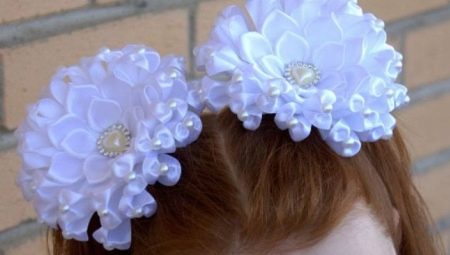Each parent wants to see their child the most beautiful, especially when such a crucial stage as studying at school begins. In order for the girls to always look smart and tidy, it is necessary to carefully monitor the hairstyle, select hair pins and bows. The most affordable and beautiful hair jewelry is kanzashi-style bows - they are easy to make with your own hands or with your child.
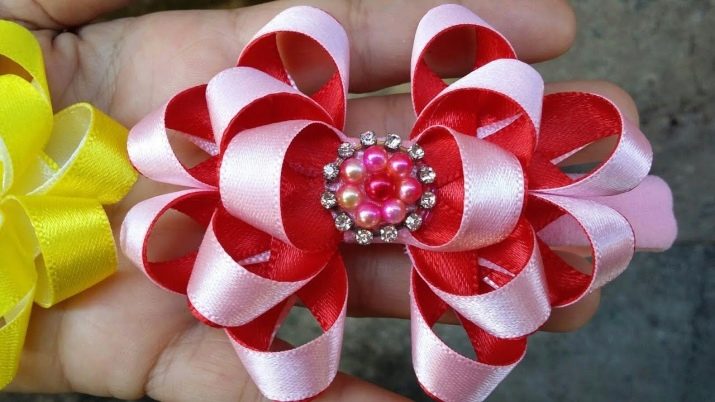
Features
Currently, the appearance of students is limited to the school uniform and strict requirements. Elastics, hairpins and other accessories should not be geeky, so strict colors are preferred: white, black, blue, cream, gray or others suitable for uniforms. In addition, the hairstyle should correspond to the event - for festive events you can use more elegant bows than for every day.
Even a small first-grader will need at least three pairs of hair ornaments to look diverse and there was a replacement in case some are lost or become worthless. Lush bows are useful for warm weather, but more compact models are needed under a hat or hood. In addition, bows can be attached to different bases: elastic, various kinds of hairpins, hairpins, ribbons, headbands. If the child straightens his hair or braids his braids himself - you must choose the option for strength.
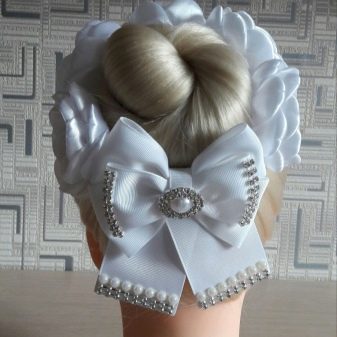

All these and other requirements are easily taken into account if you master such a technique for making hair ornaments as kanzashi. She has other advantages:
- materials and tools can be purchased everywhere and they are inexpensive;
- even beginners of any age usually quickly master simple options for making school bows;
- like any kind of creativity, kanzashi develops creative abilities and improves skills;
- do-it-yourself bows will leave no doubt in their quality, save money and become a source of pride.
For many people, a beautiful hobby turns over time into an additional source of income. This is facilitated by the fact that on the Internet there are many free workshops on making bows of varying complexity.

Tools and materials
Since kanzashi-style bows are created from pieces of fabric folded in a special way, the first thing you need to do is choose the right material before starting work. The most popular and affordable are all kinds of tapes.
- Satin. They are very beautiful in appearance, are distinguished by a wide color gamut, bright shine with beautiful tints in the light, smoothness and softness. The canvas of such a tape can be either bilateral or one-sided and needs to be cauterized at the place of cut.
- Rep. They are not inferior in strength and simplicity to satin processing, but they have more difficult weaving, which forms noticeable relief strips (scars).
- Satin. Rather strong, but at the same time soft and soft to the touch tapes with a slight shine. They can have wire edges that allow you to fix any shape.
- Lacy or openwork. They give any bows a special appeal and airiness due to complex patterns.
- Organza. Translucent, lightweight, but at the same time durable material. It is well processed, decorated and combined with other types of ribbons.
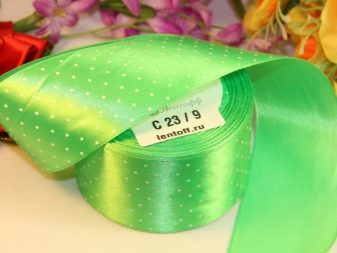
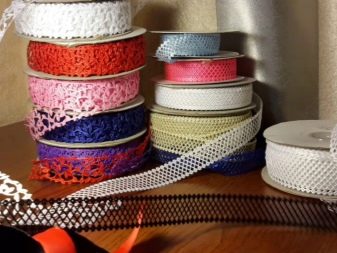
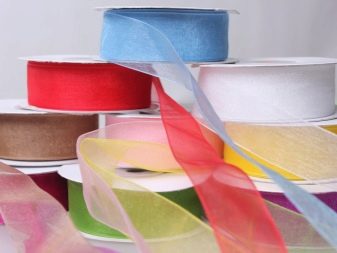

In addition to the above, in the manufacture of bows use felt for the bases, as well as all kinds of decorative elements: beads, rhinestones, crystals, sparkles. Ribbons themselves can be colored, plain, with a pattern or print.
In order not to break away from work, it is important to prepare all the necessary tools in advance:
- scissors with straight blades or a length of a figured cut, small or medium-sized scissors will be enough for cutting ribbons and thread trimming;
- ruler or tape;
- chalk or pencil for marking;
- fine needles and threads of a suitable color;
- tweezers or tweezers;
- matches, a candle or a lighter for singeing cuts;
- glue or glue gun.
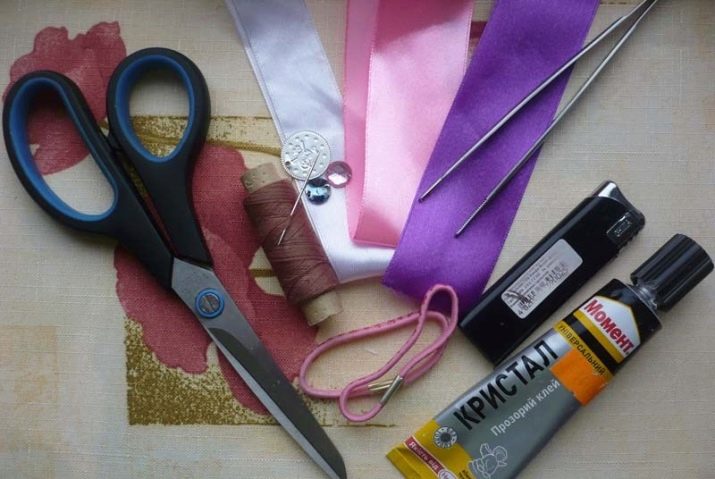
Manufacturing methods
You can talk about the variety of kanzashi art. Using various tricks and techniques, simple and multi-layer bows are made from loops, flowers with round, oval or sharp petals are created.
From tapes
As a first experience in making bows - a laconic version of narrow ribbons. To begin with, you will need two pieces, which must be folded in half in turn and scorched the slices, holding them together. The resulting rings must be stitched down on top of each other with a slight indentation, stitched and pulled in the center. To give splendor you will need a second layer. The longer tape must be folded so that its ends slightly intersect and two loops form on the sides. The center of the new blank is stitched and glued to the first layer.
The threads are easy to hide with a double or narrower ribbon folded. All sections must be scorched so that they do not crumble.

In addition to decorating hairstyles, schoolchildren will benefit from all kinds of kanzashi bows, which can be used as brooches, ties or frills. Making one of the popular options is quite simple.
- First you need to take two pieces of wide tape. Slices of each of them should be folded towards the center and fastened. The resulting rectangles need to be stitched in the center slightly overlap and assemble. Thus, a lower bow is obtained.
- A narrower rep ribbon with a contrasting pattern should be folded in the same way as the previous ones, swept in the center, but not pulled, glued in the middle. Two more of the same blanks are located diagonally, stitched, pulled together in the center and glued to the previous one.A narrow ribbon of suitable color disguises the center of a multi-tiered bow.
- The ribbons for the free part must be folded so that they form an acute angle, glue and cut the lower sections obliquely. They can be glued with contrasting braid or lace. As a second tier, shorter ribbons are glued in exactly the same way. Then, in the places of gluing, all the irregularities are cut and both parts of the tie are connected.
- The center of the upper bow and the edges of the lower ribbons are decorated in any way or left as is.
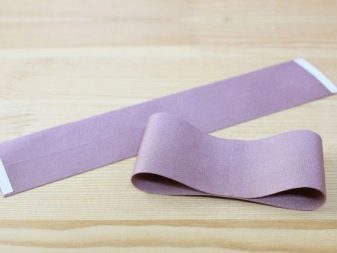
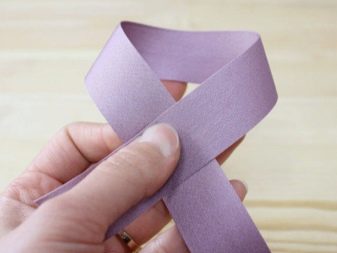
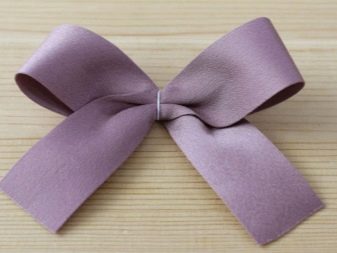
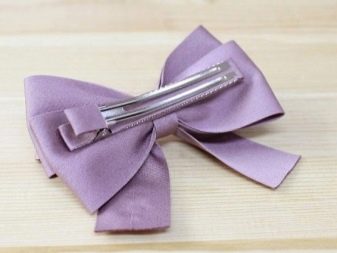
From satin ribbons you can make a simple and pretty cute-looking bow in the shape of a flower.
- A five-centimeter tape must be cut into equal segments (12 cm each).
- We bend the upper corners to the wrong side, and then lower the lower corners to the front two times and stab with pins.
- We fold the resulting workpiece with the face inward and fasten the bottom with a thread with a needle. It turns out a petal.
- Thus, we make so many petals so that they can make three circles: large, medium and small. For example, on 11, 7 and 5 petals or on 8, 6 and 3. Petals are sequentially stringed on a thread with a needle and pulled together.
- Tiers must be carefully glued together, and in the middle add a bead or rhinestones.
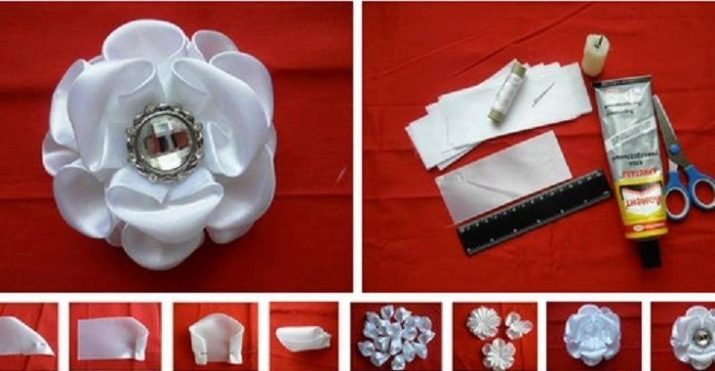
As a basis, you can use a circle of felt or any thin fabric. Another more practical option is to cut a circle of the desired diameter thin plastic (from a bottle or a package of juice), put a wider circle of satin on it and tighten it with a thread on the edge. To the base, in turn, any gum, hairpin, crocodile, etc. is attached or glued.
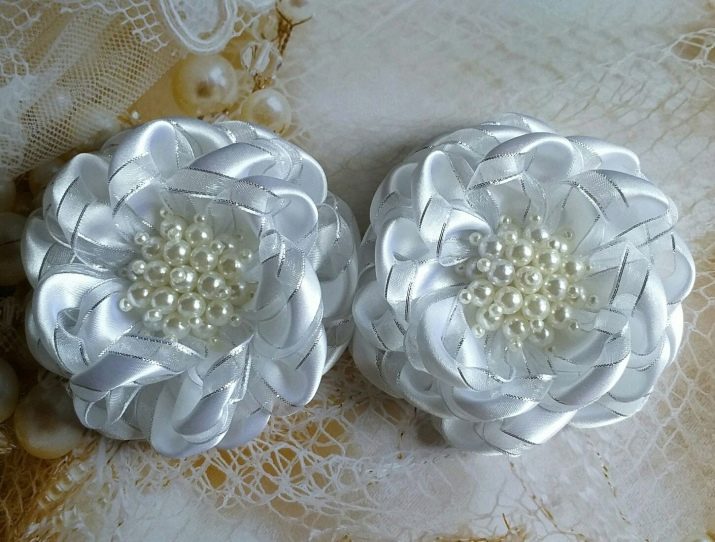
From organza
Organza ribbons are as easy to work with as satin ribbons, however, dexterity is also needed here. Start creating white air bows with a fairly simple but curvaceous model.
- Take a tape with a width of at least 4 cm and a length of 4 m. With small stitches, sew it in a zigzag so that the distance between the peaks is 8 cm. Previously, you can apply a weak markup.
- As you move forward, you need to gather the ribbon on a thread. The result should be a short blank with dense folds.
- Then it needs to be twisted in a spiral starting from the center. New turns can be hemmed from the wrong side or glued. The final step is gluing the base and decor.
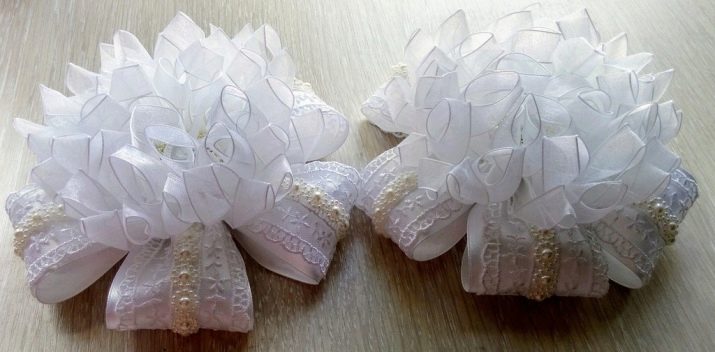
Another variety of bows in the kanzashi style allows you to master the manufacture of the finest petals, from which a lovely white flower is assembled.
- It is necessary to cut 5 circles from the canvas with a diameter of 15 cm and the same slightly less - 12 cm. Then each of them is bent in half and stitched the resulting semicircle along the edge.
- Gently collecting the seam we get round petals. They need to be assembled on one thread in size.
- As a result, we get two tiers that are easy to stitch or glue. The middle can be filled with any decorative rhinestones or beads. To make the bow look more informal, several narrow ribbons can be glued between tiers.
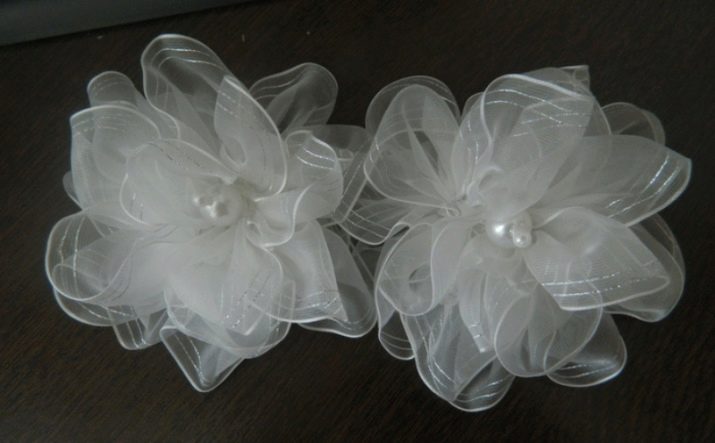
Organza goes well with any other materials. Especially original look bows from combined materials.
- In order to get unusual two-color petals, you need ribbons of two colors, each 7 cm wide. We measure out two white organza ribbons of 140 cm and one of the same satin. Then we lay the white ribbons in parallel and put blue on them in the middle. It is necessary to cut 50 petals from them on a 5 cm wide workpiece, this can be done with scissors and sealed with a lighter edge, but it is more convenient to take a soldering iron or a burner with a sharp needle.
- We pull the edge with a satin ribbon, pinch. We turn the bottom cut of the petals inward and solder.
- The next step is to glue the petals on the base circle. The more layers - the more magnificent bow. The first three layers can be made of 11 petals, and then reduce their number to 9, 6 and 2, respectively.
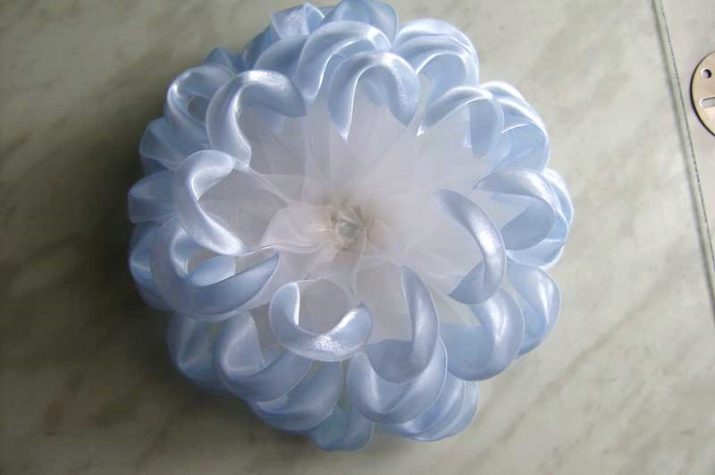
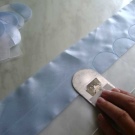
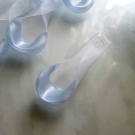
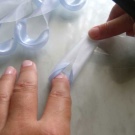

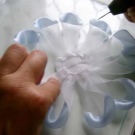
Recommendations
Many masters in this field have noted a decrease in demand for kanzashi. But along with this, most schoolgirls go on September 1 with bows made of ribbons or organza. Therefore, talk about the loss of relevance is impossible. Just unlike the time when this technique first appeared, today's fashionistas want to see more sophisticated color combinations and new models. In this way, you need to constantly improve, be aware of new products and boldly use these techniques to create unusual bows that can decorate your hair style.
It is important for beginners to choose easy-to-process material. If the purchased tapes do not hold well, the workpiece can be sprayed with varnish and allowed to dry before final assembly.
Although white is considered universal for bows to school, it is necessary to work with such ribbons carefully, since they can get dirty or change color after sealing sections.
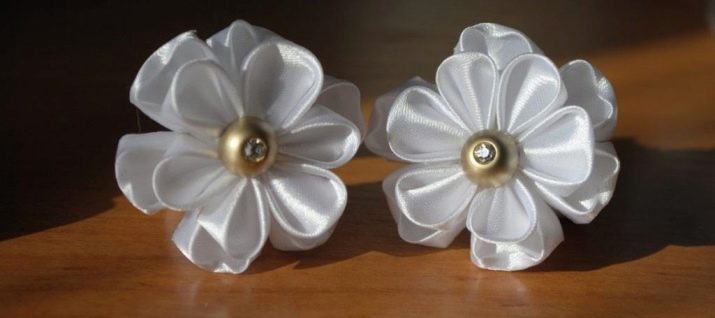
Having mastered several options for making petals, you can safely begin to experiment - to change not only the shape and size of parts, but also their location. The same applies to ordinary bows - the principles of fastening ribbons in both American and more traditional varieties are approximately the same.
In addition to manufacturing, it is important to learn how to properly care for Kansashi. Bows on hairpins are best taken in the middle, as the sides deform very quickly. Dirt from jewelry from tapes can be removed with a swab dipped in soapy water and then in clean water. Wet bows should be dried extremely carefully, smoothing and shaping all the details.
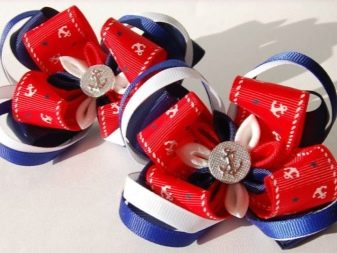
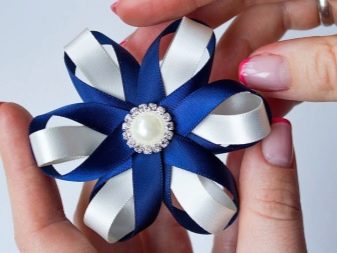
How to make a school bow from rep ribbon, see the next video.
